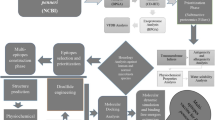Abstract
Objective
To obtain a recombinant flagellin derivative CBLB502, expressed in functionally soluble form, the technology of library construction and screening of synonymous codon variants was employed, and its expression, solubility, and activity were assessed.
Results
We screened several synonymous codon variants scvCBLB502s with the enhanced solubility from the constructed library, harboring the random substitutions of the first ten amino acid residues of the parental CBLB502 with synonymous codons. Among them, scvCBLB502-5 was purified (> 8.4 mg/l) by single step procedure using an affinity chromatography without any ancillary treatment with protease inhibitor cocktail solution and/or boiling at 90 °C. Subsequent study showed that the recombinant protein scvCBLB502-5 distinctly induced the TLR5 (Toll-Like Receptor 5)-mediated NF-κB activation and also IL-8 production in HEK293-hTLR5 cells.
Conclusion
Results showed that scvCBLB502-5, engineered through the synonymous codon substitutions, was easily expressed in functionally soluble form and maintained the proper folding to be recognized by TLR5, as an inducer for pathogen-associated molecular pattern (PAMP).




Similar content being viewed by others

References
Bergman MA, Cummings LA, Alaniz RC, Mayeda L, Fellnerova I, Cookson BT (2005) CD4+-T-cell responses generated during murine Salmonella enterica serovar Typhimurium infection are directed towards multiple epitopes within the natural antigen FliC. Infect Immun 73:7226–7235. https://doi.org/10.1128/IAI.73.11.7226-7235.2005
Burdelya LG et al (2008) An agonist of toll-like receptor 5 has radioprotective activity in mouse and primate models. Science 320:226–230. https://doi.org/10.1126/science.1154986
Cambray G, Guimaraes JC, Arkin AP (2018) Evaluation of 244,000 synthetic sequences reveals design principles to optimize translation in Escherichia coli. Nat Biotechnol 36:1005–1015. https://doi.org/10.1038/nbt.4238
Cheong DE et al (2015) Enhancing functional expression of heterologous proteins through random substitution of genetic codes in the 5′ coding region. Biotechnol Bioeng 112:822–826. https://doi.org/10.1002/bit.25478
Cheong DE, Park SY, Lim HD, Kim GJ (2019) An alternative platform for protein expression using an innate whole expression module from metagenomic DNA. Microorganisms. https://doi.org/10.3390/microorganisms7010009
Choi ES, Han SS, Cheong DE, Park MY, Kim JS, Kim GJ (2010) Generation of a fast maturating red fluorescent protein by a combined approach of elongation mutagenesis and functional salvage screening. Biochem Biophys Res Commun 391:598–603. https://doi.org/10.1016/j.bbrc.2009.11.105
Deuschle U, Kammerer W, Gentz R, Bujard H (1986) Promoters of Escherichia coli: a hierarchy of in vivo strength indicates alternate structures. EMBO J 5:2987–2994
Faezi S, Bahrmand AR, Mahdavi M, Siadat SD, Nikokar I, Sardari S, Holder IA (2016) High yield overexpression, refolding, purification and characterization of Pseudomonas aeruginosa Type B-Flagellin: an improved method without sonication. Int J Mol Cell Med 5:37–48
Goodman DB, Church GM, Kosuri S (2013) Causes and effects of N-terminal codon bias in bacterial genes. Science 342:475–479. https://doi.org/10.1126/science.1241934
Haiko J, Westerlund-Wikstrom B (2013) The role of the bacterial flagellum in adhesion and virulence. Biology (Basel) 2:1242–1267. https://doi.org/10.3390/biology2041242
Hajam IA, Dar PA, Shahnawaz I, Jaume JC, Lee JH (2017) Bacterial flagellin-a potent immunomodulatory agent. Exp Mol Med 49:e373. https://doi.org/10.1038/emm.2017.172
Khani MH, Bagheri M, Dehghanian A, Zahmatkesh A, Moradi Bidhendi S, Salehi Najafabadi Z, Banihashemi R (2019) Effect of C-terminus modification in Salmonella typhimurium FliC on protein purification efficacy and bioactivity. Mol Biotechnol 61:12–19. https://doi.org/10.1007/s12033-018-0135-y
Monk JM et al (2016) Multi-omics quantification of species variation of Escherichia coli links molecular features with strain phenotypes. Cell Syst 3(238–251):e212. https://doi.org/10.1016/j.cels.2016.08.013
Park WJ, You SH, Choi HA, Chu YJ, Kim GJ (2015) Over-expression of recombinant proteins with N-terminal His-tag via subcellular uneven distribution in Escherichia coli. Acta Biochim Biophys Sin (Shanghai) 47:488–495. https://doi.org/10.1093/abbs/gmv036
Quax TE, Claassens NJ, Soll D, van der Oost J (2015) Codon bias as a means to fine-tune gene expression. Mol Cell 59:149–161. https://doi.org/10.1016/j.molcel.2015.05.035
Simon R et al (2014) A scalable method for biochemical purification of Salmonella flagellin. Protein Expr Purif 102:1–7. https://doi.org/10.1016/j.pep.2014.07.005
Tang D, Kang R, Coyne CB, Zeh HJ, Lotze MT (2012) PAMPs and DAMPs: signal 0s that spur autophagy and immunity. Immunol Rev 249:158–175. https://doi.org/10.1111/j.1600-065X.2012.01146.x
Acknowledgements
This work was supported by Basic Science Research programs [NRF-2017R1A2B4007852 (to D.-H.L), NRF-2017R1D1A1B03035338 (to D.-E.C)] of the National Research Foundation (NRF) of Korea funded by the Ministry of Education, Science and Technology of Korea (MEST). This work was also supported by the Intelligent Synthetic Biology Center [NRF-2017030616 (to G.-J.K)] program of NRF funded by the Ministry of Science, ICT & Future Planning and supported by a Grant from Marine Biotechnology Program [20170305 (to G.-J.K)] funded by Ministry of Oceans and Fisheries, Korea.
Supporting information
Supplementary Fig. 1 Expression pattern of opt-CBLB502 under T7 promoter in E. coli BL21 (DE3). T and S means total and soluble fraction, respectively. Red arrow indicates opt-CBLB502. M, protein size marker.
Supplementary Fig. 2 Codon substitutions in the 5′-coding region of each selected variants.
Supplementary Fig. 3 The relative fluorescence intensity of mCherry for each mCherry-fused variant. Fluorescence intensity of 12 screened scvCBLB502s was assessed with a microplate reader.
Author information
Authors and Affiliations
Contributions
G-JK and D-HL designed research, analyzed the data, and wrote the paper. D-EC designed research, performed the experiments, analyzed the data, and wrote the paper. J-HL performed the research experiments and analyzed the data. H-JC performed the research experiments and analyzed the data. S-KY performed the research experiments and analyzed the data.
Corresponding authors
Ethics declarations
Conflict of interest
All authors declare no competing interests.
Additional information
Publisher's Note
Springer Nature remains neutral with regard to jurisdictional claims in published maps and institutional affiliations.
Electronic supplementary material
Below is the link to the electronic supplementary material.
Rights and permissions
About this article
Cite this article
Cheong, DE., Lee, J., Choi, HJ. et al. Soluble overexpression of a flagellin derivative from Salmonella enterica using synonymous codon substitutions of 5′-coding region in Escherichia coli. Biotechnol Lett 41, 1275–1282 (2019). https://doi.org/10.1007/s10529-019-02733-y
Received:
Accepted:
Published:
Issue Date:
DOI: https://doi.org/10.1007/s10529-019-02733-y



